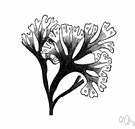INCI: Water, butylene glycol, trehalose, hydrogenated lecithin, carbomer,
chondrus crispus (carrageenan), sodium phosphate, sodium hydroxide, glyceryl caprylate
Few plants stack up to the wealth of skin nourishing nutrients found in
Chondrus crispus (Irish moss), a red seaweed that lives off the rocky shores of the North Atlantic Ocean.
Feed supplementation with red seaweeds,
Chondrus crispus and Sarcodiotheca gaudichaudii, affects performance, egg quality, and gut microbiota of layer hens.
(Goldstein, 1973; Santelices & Fonck, 1979; Pizarro & Santelices, 1993; Westermeier et al., 1999),
Chondrus crispus (Neish & Fox, 1971), Kappaphycus alvarezii (Bulboa & Paula, 2005), and Chondracanthus chamissoi (Bulboa et al., 2005; Bulboa & Macchiavello, 2006).
digitata, and Alaria esculenta (TPC varying from 13.8 to 30 g phloroglucinol equivalents (PGE) per 100 g of extract), red algae Palmaria palmata and
Chondrus crispus, and the green algae (Ulva lactuca) with values ranging from 0.4 to 24.2 g PGE per 100 g of extract.
[21, 24, 19], carrageenan from red algae; Kappaphycus alvarezii, Eucheuma denticulatum [21, 19],
Chondrus crispus [22, 23, 19], alginate from brown algae; Laminaria spp., Macrocystis spp., Ascophyllum spp.
Here the releve 235 had been extracted from that source is presented as the holotype: France, Bretagne, upper infralittoral, growing on rock face, exposed to wave action (cover scale: + to 5): Laminaria hyperborea 4,
Chondrus crispus 2, Ellisolandia elongata 2, Laminaria digitata 2, Palmaria palmata 2, Saccorhiza polyschides 2, Callophyllis laciniata 1, Corallina officinalis 1, Cryptopleura ramosa 1, Dilsea carnosa 1, Furcellaria lumbricalis 1, Halurus flosculosus 1, Membranoptera alata 1, Osmundea pinnatifida 1, Calliblepharis jubata +, Callithamnion tetragonum +, Ceramium virgatum +, Chondracanthus acicularis +, Claviclonium ovatum +, Codium tomentosum +, Desmarestia aculeata +, Gelidium pulchellum +, Halurus equisetifolius +, Heterosiphonia plumosa +, Plocamium cartilagineum +.
angusta and
Chondrus crispus in these aspects (Table 1).
Chondrus crispus), has an ability to bind water and form a gel after heat treatment.
Spatial and temporal variations of
Chondrus crispus (Gigartinaceae, Rhodophyta) carrageenan content in natural populations from Galicia (NW Spain).
The species
Chondrus crispus and Mastocarpus stellatus were the first seaweed used for carrageenan extraction.
 Chondrus crispus - dark purple edible seaweed of the Atlantic coasts of Europe and North America
Chondrus crispus - dark purple edible seaweed of the Atlantic coasts of Europe and North America